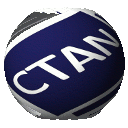Directory macros/latex/contrib/lectures
Lectures
A LaTeX documentclass for lecture notes.
Usage
Including the document class
You can include the document class lectures as follows (the default language is english):
\documentclass{lectures}
To specify a particular language (currently supported just italian and english) you can do the following:
\documentclass[italian]{lectures}
or, analogously:
\documentclass[english]{lectures}
Title page
One of the main features of the library is the provided title page. You can create it as follows:
\documentclass{lectures} \begin{document} \maketitle{ Your title }{ First author name,Second author name }{ First professor name,Second professor name }{ Parlo Parloni,Parletti Parini }{ Year }{ CFU of the course }{ Informatica }{ University name }{ Country } \end{document}
Features
Silenced useless warnings
Using the package silence the library silences the following warnings:
latex:- You have requested package
- There were undefined references
- Command
latexfont:- Size substitutions with differences
- Font shape
biblatex:- Using fall-back BibTeX(8)
- Please (re)run BibTeX on the file(s)
auxhook:- Cannot patch
glossaries:- No printglossary or printglossaries found.
Float related gimmicks
All floating objects are automatically centered and set to H as position with other objects.
Table related gimmicks
L, C and R
New column types are given L, C, and R, that allow for automatic mathmode in columns.
Example usage:
\documentclass{lectures} \begin{document} \begin{tabular}{L C R} a & b & c \\ \alpha & \beta & \gamma \\ x_1 & x_2 & x_3 \\ \end{tabular} \end{document}
Theorems related gimmicks
All theorems are in definition style, meaning that they are not in italic. All environments are color-coded to facilitate reading and reviewing.
Proofs are treated as theorem environments.
The following theorem-like environments are provided:
axiom: Fundamental principles assumed to be true.goal: Objectives or targets to be achieved.definition: Precise explanations of terms or concepts.fact: Statements that are objectively true.theorem: Proven statements based on axioms and other theorems.lemma: Helper theorems used to prove larger results.claim: Assertions that need to be proven.corollary: Results that follow directly from theorems.property: Characteristics or attributes of objects.proposition: Important statements that are proven true.observation: Noteworthy remarks or insights.conclusion: Final statements derived from proofs or discussions.generalization: Broader statements derived from specific cases.problem: Questions or challenges to be solved.example: Illustrative instances or cases.solution: Answers or methods for solving problems.analysis: Detailed examination of elements or structure.complexity: Discussion of the computational complexity.proof: Logical arguments establishing the truth of statements.
Example usage:
\documentclass{lectures} \begin{document} \begin{theorem}[Pythagorean Theorem] In a right-angled triangle, the square of the hypotenuse is equal to the sum of the squares of the other two sides. \begin{equation} a^2 + b^2 = c^2 \end{equation} \end{theorem} \begin{proof} This can be proven using the properties of similar triangles. \end{proof} \begin{definition}[Prime Number] A prime number is a natural number greater than 1 that has no positive divisors other than 1 and itself. \end{definition} \end{document}
Or if you selected the Italian language:
Lists related gimmicks
- Lists are built to be more compact and leave less blank space.
- Using the environment
todolistit is possible to create checklists.
Example usage:
\documentclass{lectures} \begin{document} \begin{todolist} \item Complete the assignment \item Review the lecture notes \item Prepare for the exam \end{todolist} \end{document}
Additional gimmicks
- When a page is empty, Latex won't generate page number or other page elements.
- When you want to leave a blank line you can just leave a blank line, without adding
\\. - If you'd like to use roman numerals there a command for that:
\rom{your number goes here}.
License
All the code in this repository is released under the MIT license. For more information, please refer to the LICENSE file.
Download the contents of this package in one zip archive (124.7k).
lectures – A document class for quickly drafting nice looking lecture notes
This LaTeX documentclass provides a number of gimmicks to draft nice looking lecture notes, such as a number of theorem environments, automatic spacing and alignment of figures and much more. More information is available in the package readme.
| Package | lectures |
| Bug tracker | https://github.com/LucaCappelletti94/lectures/issues |
| Repository | https://github.com/LucaCappelletti94/lectures |
| Version | 1.0.7 2025-03-15 |
| Licenses | MIT License |
| Copyright | 2019–2025 Luca Cappelletti |
| Maintainer | Luca Cappelletti |
| Contained in | TeX Live as lectures MiKTeX as lectures |
| Topics | Class Teaching |








